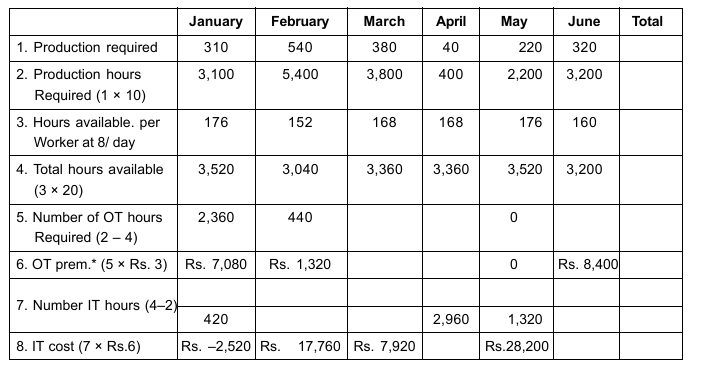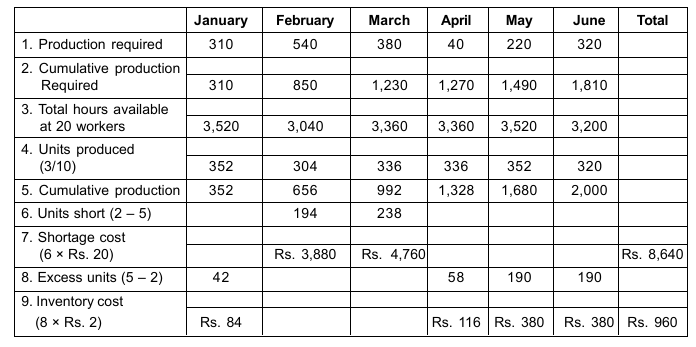| January | February | March | April | May | June | |
| Forecast demand | 300 | 500 | 400 | 100 | 200 | 300 |
| Workdays | 22 | 19 | 21 | 21 | 22 | 20 |
| Work hr at 8 per day | 176 | 152 | 168 | 168 | 176 | 160 |
Three aggregate plans are proposed.
Plan 1: Vary work force size to accommodate demand.
Plan 2: Maintain constant work force of 20, and use overtime and idle time to meet demand.
Plan 3: Maintain constant work force of 20, and build inventory or incur Stockout cost. The firm must begin January with the 50-unit inventory on hand.
Compare the costs of the three plans in table form.
Solution:
: We must first determine what the production requirements are, as adjusted to include a safety stock of 20 per cent of next month’s forecast. Beginning with a January inventory of 50, each subsequent month’s inventory reflects the difference between the forecast demand and the production requirement of the previous month. See Table 2. The costs of the three plans are shown in Tables 3, 4, and 5.
| Forecast demand | Cumulative demand | Safety stock @20 per cent forecast | Beginning inventory | Production requirement (fest. + SS – beg. inv.) | |
| January | 300 | 300 | 60 | 50 | 300 + 60 – 50 = 310 |
| February | 500 | 800 | 100 | 60 | 500 + 100 – 60 = 540 |
| March | 400 | 1,200 | 80 | 100 | 400 + 80 – 100 = 380 |
| April | 100 | 1,300 | 20 | 80 | 100 + 20 – 80 = 40 |
| May | 200 | 1,500 | 40 | 20 | 200 + 40 – 20 = 220 |
| June | 300 | 1,800 | 60 | 40 | 300 + 60 – 40 = 320 |
| January | February | March | April | May | June | Total |
| 1. Production required | 310 | 540 | 380 | 40 | 220 | 320 |
| 2. Production hours Required (1 × 10) | 3,100 | 5,400 | 3,800 | 400 | 2,200 | 3,200 |
| 3. Hours available per Worker at 8/day | 176 | 152 | 168 | 168 | 176 | 160 |
| 4. Number of workers Required (2/3) | 18 | 36 | 23 | 3 | 13 | 20 |
| 5. Number of workers Hired | 18 | 10 | 7 | |||
| 6. Hiring cost (S × Rs. 300) | Rs. 5,400 | Rs. 3,000 | Rs. 2,100 | Rs. 10,500 | ||
| 7. Number of workers Laid off | 2 | 13 | 20 | |||
| 8. Layoff cost (7 × Rs. 400) | Rs. 800 | Rs. 5,200 | Rs. 8,000 | Rs. 14,000 |

*Incremental cost of OT = overtime cost – regular time cost = Rs. 9 – Rs. 6 = Rs. 3.

Note that plan 3 assumes that a Stockout cost is incurred if safety stock is not maintained at prescribed levels of 20 per cent of forecast. The firm is in effect managing the safety-stock level to yield a specific degree of protection by absorbing the cost of carrying the safety stock as a policy decision.
Total Views: 10
